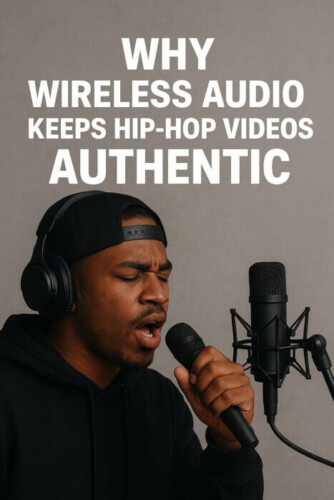Hip-hop is more than music—it’s a conversation with the world. From cyphers on the corner to viral freestyles filmed on a phone, the culture thrives on energy, rhythm, and expression. But there’s one detail that often gets overlooked: the sound. If your audio is off—too quiet, muffled by wind, or drowned by city noise—the impact is lost.
For years, creators relied on camera mics or wired setups, but those approaches clash with hip-hop’s raw, mobile energy. Artists need freedom, movement, and a setup that matches the pace of their creativity. That’s why wireless microphones are becoming the quiet but essential backbone of modern hip-hop content.
Why sound matters as much as visuals
You can shoot in 4K with flawless framing, but if the words don’t cut through, the message disappears. Hip-hop is built on voice—cadence, emphasis, tone. An MC’s delivery is not just about what they say but how they say it. Every pause, breath, and punchline has weight.
Bad audio masks these details. A tinny onboard mic or distorted signal doesn’t just sound cheap—it undermines authenticity. In contrast, clean wireless audio lets the listener hear the performance as intended, with the same clarity as a studio recording, but captured live in the moment.
Lavalier mics: subtle, powerful, reliable
One of the most common solutions for hip-hop creators today is the lavalier, or lapel, mic. These tiny microphones clip discreetly onto clothing and stay close to the performer’s mouth, delivering consistent, natural sound.
The beauty of Wireless Lavalier Microphones is that they follow the performer. Whether you’re bouncing through a verse, pacing around the block, or switching angles mid-take, the sound remains steady. For interviews, podcast-style sit-downs, or even documentary-style storytelling, lavaliers are the definition of versatility. They don’t steal focus visually but make sure the words always cut through the mix.
Clip-on systems: built for speed
Sometimes, subtlety isn’t the priority—speed is. Imagine catching a freestyle right after a show, recording an artist in the car park, or grabbing quick vox pops outside the club. You don’t have time to thread cables under shirts or hide tiny capsules.
That’s where a Wireless Clip on Microphone shines. These all-in-one devices attach in seconds and are instantly ready to capture sound. They’re more visible than a lav, but when spontaneity is the name of the game, convenience is king. Clip-ons are especially useful for vloggers, behind-the-scenes content creators, and street reporters covering hip-hop culture on the move.
Keeping it clean in noisy environments
Recording in the heart of the city is part of hip-hop’s identity. Street noise, passing cars, chatter from crowds—it all adds atmosphere. But uncontrolled, it can also overwhelm your audio. Wireless systems give you control by keeping the mic close to the mouth, ensuring the voice dominates the mix.
Still, there are best practices. Always carry windshields when filming outdoors; even a light breeze can ruin a perfect take. Place mics centrally on the chest to capture speech evenly. Keep jewellery and zips away from the capsule to avoid unwanted noise. And when you can, scout a location that offers the vibe you want without swallowing your sound.
Wireless in the age of movement
Hip-hop content thrives on mobility. From rapid-fire TikToks and Instagram reels to full-length YouTube documentaries, the culture moves faster than ever. Wireless systems support that energy. They let camera operators roam freely without cables tripping them up. They allow artists to perform without being tethered to a mic stand. And they give editors reliable, clean tracks to work with, saving time in post-production.
This freedom is especially valuable for cypher videos. Imagine four or five MCs trading bars in a circle. A wireless system ensures each voice comes through clearly, even as the camera pans or tracks around the group. The result? A recording that feels alive but still polished.
Avoiding wireless pitfalls
Of course, wireless technology has its challenges. Urban environments are packed with signals—Wi-Fi, Bluetooth, mobile data—all competing for space. That’s why choosing systems with automatic frequency scanning or hopping is vital. Keeping line of sight between transmitter and receiver also improves reliability.
Creators should also be mindful of power. Wireless packs run on rechargeable batteries, and nothing kills momentum like a dead transmitter mid-take. Always carry spares or portable power banks. Preparation keeps the vibe flowing when inspiration strikes.
Real-world scenarios
Think about where hip-hop content is filmed today and it’s easy to see the need for wireless systems:
- Cyphers in the streets: Keep every verse sharp even with a moving camera.
- Studio sessions: Capture candid conversations and process talk without cables cluttering the space.
- On-tour diaries: Film backstage moments, bus freestyles, and fan interactions with audio that feels immediate and real.
- Street interviews: Reporters and creators can grab thoughts from fans and artists on the spot without setup delays.
- Music video behind-the-scenes: Directors can talk through shots and artists can reflect in real-time with clean sound.
In each case, wireless gear respects the culture’s rhythm: fast, expressive, and unfiltered.
The future of hip-hop content
As technology continues to evolve, one thing remains the same: authenticity. Hip-hop fans demand it. They want to feel the rawness, the honesty, the pulse of the streets. Wireless microphones aren’t about making things look glossy or corporate—they’re about ensuring the message lands exactly as delivered.
For young creators starting out, they’re an affordable way to raise production value instantly. For established artists, they’re a tool that guarantees the music and words are heard without distraction. Either way, they’re becoming as essential to hip-hop content as the camera itself.
Closing thoughts
Hip-hop has always thrived on accessibility—anyone with a voice and a beat can join the conversation. But in today’s digital landscape, being heard clearly is as important as being seen. Wireless audio systems give creators the freedom, clarity, and reliability to let their craft speak for itself. Whether you’re documenting a freestyle in the park, interviewing an artist after a gig, or filming a studio session, the right microphone keeps the words sharp and the culture authentic.
© 2025, Tedfuel. All rights reserved.








